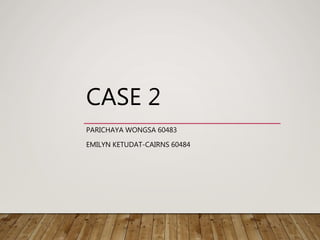
CASE2 Borrelia burgdorferi .ppt
- 1. CASE 2 PARICHAYA WONGSA 60483 EMILYN KETUDAT-CAIRNS 60484
- 2. This 12-year-old girl was in her normal state of good health when she developed a fever of several days duration. She had no localizing symptoms, except for the development of a large rash on her back (Fig. 1). Her history was notable in that she lived in Connecticut near the New York State border and had recently been walking through a tall grass where her sister was taking a horseback riding lesions.
- 3. WHICH MICROORGANISM WAS SHE INFECTED? WHAT DISEASE DID SHE HAVE? • She was infected by Borrelia burgdorferi • Lyme Disease Borrelia burgdorferi causes Lyme disease (named after a town in Connecticut). Lyme disease is also known as Lyme borreliosis Lyme disease is the most common tick-borne disease in the United States. It is also the most common vector-borne disease in the United States.
- 4. WHAT IN HER HISTORY WAS SUGGESTIVE OF THIS DISEASE? HOW IS THE DISEASE TRANSMITTED? • It was mentioned from her history that she walks through tall grass where she did horseback ride lessons. It is transmitted through vectors transmission by the ticks from the horse.
- 10. PATHOGENESIS OF LYME DISEASE CAUSED BY BORRELIA BURGDORFERI
- 11. Stage 1 (early localized stage), Erythema chronicum migrans (also called erythema migrans), an expanding, erythematous, macular rash that often has a “target” or “bull’s eye” appearance. The rash appears between 3 and 30 days after the tick bite. Both the tick bite and the rash are painless and nonpruritic. The rash may sometimes be accompanied by nonspecific “flulike” symptoms such as fever, chills, fatigue, and headache. Secondary skin lesions frequently occur. Arthralgias, but not arthritis, are another common finding in this early stage. In approximately 25% of cases of Lyme disease, no rash is seen.
- 12. tage 2 (early disseminated stage), • Occurs weeks to months later, • Cardiac and neurologic involvement predominates. Myocarditis, accompanied by various forms of heart block, occurs. Acute (aseptic) meningitis and cranial neuropathies, such as facial nerve palsy (Bell’s palsy), are prominent during this stage. • Bilateral facial nerve palsy is highly suggestive of Lyme disease. • Peripheral neuropathies also occur.
- 13. latent phase lasting weeks to months typically ensues. Stage 3 (late disseminated stage) • Arthritis, usually of the large joints (e.g., knees), is a characteristic finding. It develops in almost two-thirds of untreated patients. • Lyme arthritis is thought to be autoimmune in origin. • Encephalopathy also occurs in stage 3. • Some patients treated for Lyme infection continue to have prolonged subjective symptoms of fatigue, joint pains, or mental status changes after objective findings have disappeared.
- 14. • Culture of the organism is rarely positive, usually not performed. • The diagnosis in later stages of disease usually rests on the demonstration of circulating antibodies to B burgdorferi. • Recommended diagnosis procedure is to first perform a sensitive screening test (enzyme immunoassay) followed by an immunoblot (Western blot), which detects specific antigens of the organism.
- 15. • Diagnosis of early Lyme disease is based on exposure and typical clinical findings. (most common is erythema migrant (3 stages, early localized stage, early disseminated stage(cardiac & neurologic), late disseminated stagearthritis) )
- 16. • Detecting either IgM antibody or detect rising of IgG antibody with ELISA or with an indirect immunofluorescence test. • IgM is detectable after 2 weeks after infections, peaks at 3-6 weeks. Test for IgG more reliable after 30 days of infection. • Can be problematic because of presence of cross-reacting antibodies against spirochetes in normal flora. Should perform western blots test after.
- 17. • Dr. Burrascano stats bands 18, 23-25, 31, 34, 37, 39, 83, 93.(no other disease can cause these to be positive.
- 18. • Nucleic acid amplication(PCR) procedures able to detect B.burgdorferi- specific DNA sequences in body fluids (joint, CSF) is available.
- 19. • Stage 1 and mild manifestations similar to stage 1 Treated with Doxycycline, amoxicilin, and cefuroxime axetil via oral treatment, patient usually recover rapidly and completely. In more complicated cases treatment may take anywhere from 3 weeks to a little bit more than a month before complete recovery Caution! Should the patient have illness related to either neurological or cardiac form, Intravenous treatment using drugs ceftriaxone or penicillin
- 20. For some unfortunate patient, the symptom of the disease may last more than six months! This is called Chronic Lyme Disease or Post-treatment Lyme Disease Syndrome (short PTLDS) As of now there is no guaranteed treatment for the lingering effects. In fact, long-term antibiotic treatment may be harmful to health.
- 21. Patient suffering from lingering effects of PTLDS will recover but with time. There are medicines aimed to relieve the patients from pain and discomfort from PTLDS and it is case-by-base. Continuation usage of antibiotics is not recommended
- 23. Prophylactic antibiotics should be given in regard to 2 main factors • The percentage of infected tick in the area • The length of time the tick has fed on the person If the risk is high patient should be given doxycycline to prevent the disease
- 24. Any person bitten by a tick should watch carefully to rash or flu-like symptoms for the next 3 weeks The vaccine containing outer surface protein as the immunogen is no longer recommended
- 25. THANK YOU